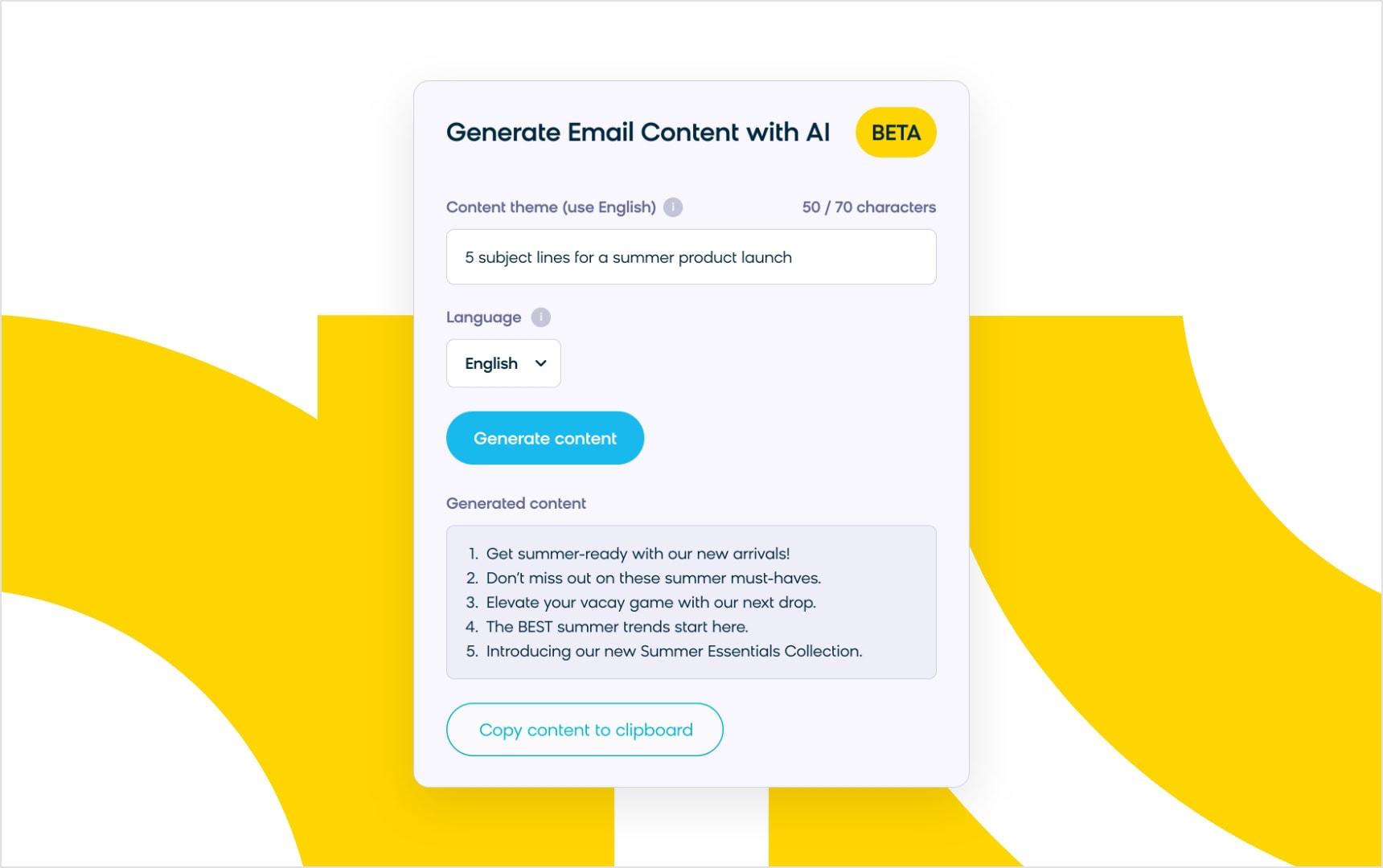Right now, generative AI is clearly having its moment. Big tech companies like Microsoft, Google, and Amazon are investing in generative AI startups and technology. You’ve probably already seen countless stories about AI models (and more specifically, ChatGPT) popping up in your news feeds. Moreover, these generative AI models have proven extremely successful. For example, ChatGPT reached 100 million active users in under 60 days. Meanwhile, it took Facebook four years to do the same.

And if you’re in marketing or commerce? You’re probably trying to figure out how generative AI can be used most effectively to produce the highest ROI. This is key because AI isn’t simply a passing fad like some of the other new technology we’ve seen in recent years — it represents the evolution of how technology can supplement (and in some cases, even replace) the work we do.
To that end, it’s also critical for you to know what generative AI can and cannot do in its current state, as well as what this means for the future of commerce and marketing. Read on for my thoughts.
The Current State of Generative AI
While you can dive deeper into the intricacies of how ChatGPT works, even a surface-level interaction with the tool shows how impressive it is. Recent advancements in the generative AI industry have the potential to radically alter how commerce and marketing professionals approach content development. Anyone thinking about creating customer-focused content has probably already started discussing how they can use generative AI models to increase productivity and revenue.
But, we also can’t forget that despite the splash that ChatGPT and generative AI has made, it’s still really early days for the technology. ChatGPT may not even be the ultimate “winner” of the generative AI battles, but it’s definitely paving the way. There are still a lot of wrinkles to iron out (such as limitations to the data being indexed), but the technology will only continue to improve.
So yes, it’s early days, but the potential impact we’ll likely see from this technology in the near future is astounding.
The Potential To Transform
There’s already a wide range of applications for generative AI models: content generation (text, images, video, etc.), coding and development, automation (customer support, search results, manual tasks, etc.), and much more. AI models will soon be saving businesses everywhere time, resources, and money.
So, what does that mean for commerce and marketing?
Personalization and Content
Customers seek personalized content, and generative AI can be an incredibly useful tool here. In a McKinsey study, 71% of customers want personalization and 76% get frustrated when their experience is not personalized. AI plays a role in omnichannel marketing by customizing and improving the whole customer experience across numerous channels. It collects and analyzes data on customers and goods to drive marketing efforts, anticipate channels on which customers are more likely to convert, and automate repetitive processes.
To understand how generative AI can help with personalization, you must first look at content. Generative AI can enable marketers and merchandisers to scale multiple variations of product descriptions and texts. You can already see this being applied to email subject line testing, with more to follow soon.
In general, you need to remember that the tighter your segmentation and the more sophisticated your personalization goals, the more material you’ll require. Even creating several variants of site banners, merchandising assets, and email content is often too time-consuming and labor-intensive for most companies. For ecommerce businesses, simply getting the resources together to deliver one version of everything on time can be a struggle.
As a result of too few content variations, personalization gets hampered. And that’s where generative AI can step up — by helping ecommerce brands scale up their content efforts quickly and efficiently.
But it’s critical to remember that content alone will not suffice for personalization. You need a powerful, real-time machine-learning application to test all that content and optimize it at scale to maximize engagement. After all, generative AI is simply a tool you can use. It will not replace high-quality content and a personalized and optimized marketing plan.
There’s potential and opportunity for generative AI to do a lot more with graphical content in ecommerce too, such as producing images and videos at scale. Eventually, generative AI can also help create content like product demos, tutorials, lifestyle/brand content, website images, marketing assets (e.g., emails, ads, and social posts), and more. It’s still early in the evolution of AI models, but generative AI will eventually be able to produce images and videos of similar quality to the written content it can already generate. In short, generative AI will be able to create a whole range of marketing collateral that is personalized and engaging for customers.
Experiences and Discovery
Generative AI is changing how people search for and discover information. Now, you can ask generative AI tools like ChatGPT a question and get an immediate summary back. While it still needs to be double-checked, it’s faster than sifting through search results yourself. These systems aren’t quite there yet for ecommerce and product discovery, but they’re getting there.
Customer product discovery has also advanced with solutions like generative models, self-learning AI, and natural language processing. But the likely next step in generative AI is conversational commerce. Conversational commerce is all about creating chat-based experiences for shoppers that feel natural. Generative AI models are a form of large language model, or LLM. LLMs are learning models that involve a machine learning system that detects, summarizes, translates, forecasts, and synthesizes text and other material from vast datasets.
Machine learning systems, such as large language models, are now routinely trained on large datasets. Today, many of these datasets are extensive enough to incorporate almost everything posted on the internet over a long period of time. Massive amounts of data are used as training data for language learning models, and this volume of data is, as the name implies, crucial to its operation. However, how we define “large” is expanding with generative AI.
Unsupervised learning occurs when a model is given training data without clear instructions on what to do with it. This process involves feeding enormous volumes of text into a generative AI model. Through this method, an LLM learns words, as well as the relationships between them and the concepts behind them. For example, it can learn to distinguish between the different meanings of the word “bark” based on the context.
Generative AI and other large language models may also be fine-tuned or prompt-tuned in certain cases. This is the act of providing the model with small chunks of training data to focus on. For example, instead of searching for “red sundress,” you can search for “I am looking for a red sundress that’s appropriate for brunch and that I can also wear to work.”
Once the results show up, you might say something like, “I like the one on the left; do you have more like that?” Being able to find the right results is vital to get usable information. Customers don’t want to wade through all the possibilities that come up if they search for a simple term such as “red sundress.”
The best part is, the next step of this technology is right around the corner. Bloomreach already has functioning prototypes that interact with GPT-3. And soon, we’ll be able to bring industry-leading commerce search to customers in a more conversational way — think of it as the next generation of guided sales.
And one more thing — often, when discussing generative AI and ecommerce, the focus is on B2C vs. B2B. But even though it’s still digitally immature, B2B ecommerce was worth $18 trillion in 2021, five times more than B2C. Ecommerce product discovery is making strides, so keep B2B in mind when mapping out your AI strategies for the future.
Digital Marketing
Digital marketing can be tough since it includes campaigns, promotions, and cross-selling, all supported by content such as emails, SMS, social media, and display ads. In addition, marketing managers must consider SEO, gamification, loyalty, partnerships, and brand awareness. It can feel like a neverending list for digital marketers, and an especially tough task to generate fresh and interesting ideas for all these marketing materials. This is where generative AI comes into play.
As I mentioned earlier, generative AI helps scale content creation, and that applies to brainstorming and idea generation as well. But I also mentioned that generative AI is still in its early days, which means the output still needs to be fine-tuned and constantly checked. There also needs to be better guardrails for things like brand voice and intellectual property — a big topic that we collectively need to tackle in a thoughtful manner. The result is that a lot of content right now is easily identifiable as created by AI since it can’t quite match the brand voice that customers expect.
Fortunately, as the technology continues to evolve, we’ll see generative AI pave the way for the other half of the conversational commerce coin: conversational marketing. This is where, instead of being marketed to, brands open a conversation with consumers to engage them. This type of marketing is also an excellent opportunity to gather valuable zero-party data, which is when customers explicitly and intentionally give your business data. If you can engage in ongoing interactions with customers, you’ll hear directly from them what they want, which means you can better personalize recommendations and content for them. And ultimately, that’ll translate into more conversions and revenue.
Beyond content, generative AI will also make it easier to segment customers in advanced ways. Generative AI-based data exploration tools will help marketers streamline workflows, improve campaign performance, and maximize ROI. The better companies can effectively use generative AI, the more willing customers will be to provide the zero-party data necessary to make these AI tools even more effective.
All of this sounds fantastic and exciting, but we do have to be wary of some big pitfalls. For example, generative AI, when used in combination with optimization techniques and automation, can lead to a proliferation of “sameness.” That’s where the human touch in marketing has to play a bigger role, and it’s where a lot of digital marketing jobs might transform from content creation to content editing. That’ll be key to standing out from the competition and engaging your customers.
What’s the Takeaway From Generative AI?
Generative AI is a huge topic, and we’ve only scratched the surface here. No matter how you feel about AI, there’s no denying that it’ll have a huge impact on commerce and marketing. Will you stay ahead of the game or get cast aside by the waves of change?
To learn more about generative AI and its impact on the future of ecommerce, check out the replay of The Edge Summit on-demand. The Edge Summit brought together together experts to discuss the new trends in digital marketing, ecommerce, and AI. Stay ahead of the curve by watching on-demand!


















